We asked the live-aboard sailors on four voyaging vessels some questions about the battery setups on their boats. Each had a different opinion on the challenge of meeting their voyaging electrical demands.
Ginger and Dick Stevenson on the Valiant 42 Alchemy — The Stevensons have been live-aboard voyagers for the past 15 years. Ginger was a first-grade teacher and Dick a clinical psychologist/psychoanalyst. They started sailing together on a family-owned sunfish and then bought their own Cape Dory Typhoon, followed by a Sabre 28, and then a LeComte Northeast 38 designed by Bill Tripp. They sailed this boat many times back and forth from the East Coast to Bermuda. After their children went off to college, they sold their house and bought their current boat, a Valiant 42 called Alchemy. Aboard Alchemy they have cruised the Bahamas and the Caribbean, the length of the Mediterranean and more. They greatly enjoy the voyaging lifestyle and intend to cruise indefinitely.
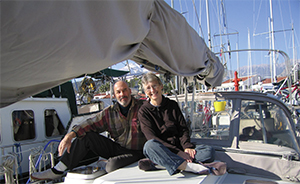 |
|
The Stevensons aboard Alchemy. |
|
Dick Stevenson |
Ocean Navigator: What type of batteries do you use on board?
Ginger and Dick Stevenson: We use gel cells, and I believe that manufacturer is important so in North America I buy East Penn. I have been using gels for probably 25-plus years now (a guess) and on two different boats. I find gels easy to use (no need for filling with special water, nor need to test specific gravity), clean (flooded battery’s electrolyte has ruined many a piece of my clothing, and residue always accumulates on battery tops and around terminals, requiring cleaning) and quite forgiving of my occasional mistakes leading to full discharge and other abuses.
I believe that AGMs nowadays may be the better choice, but I am still concerned about their need to be fully charged with some degree of regularity. As we are often anchored out for long periods, getting a full charge is very difficult. I find the argument that AGMs can absorb a fast charge at once very accurate, but in the end very seductively misleading, as it is a rare boat that can generate the kind of charging amps to make use of that attribute. I have considered going to AGMs the next battery swap. If I choose not to, it will be because I will consider the benefits to not warrant all the work of changing the charging schedule on the regulators, battery chargers, etc., and the learning curve of caring for a new battery type.
ON: What is the capacity of your battery banks?
G&DS: Our house bank is approximately 12 volts, 570 amps (starter battery plus 95 amps) — six batteries in the house bank and one starter battery, all gel, all the same size.
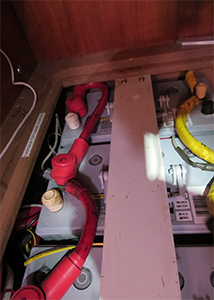 |
|
A battery bank aboard Alchemy showing the battery retaining bar in place. |
|
Dick Stevenson |
ON: Do you use any type of battery management system for charging and measuring state of charge?
G&DS: We use a 20-year-old Xantrex Link 20 battery monitoring system, but we only use its quite accurate voltage-metering feature as well as its measurements of amps in or out. For a few years, I played with the capacity of the Link system to measure amps used/percent depleted, as well as time left until a predetermined level of amps used was reached; I didn’t find this useful on an ongoing basis. As I check voltage level and amps-out together multiple times a day, over the years I fairly quickly could discern a close enough approximation to the charge state of the battery bank to satisfy our needs. I find all the fine-tuning of instrumentation, calibration and monitoring among cruisers to be more of a hobby than a realistic contribution to battery management.
ON: What changes, if any, do you plan to make to your battery setup?
G&DS: Other than the slim possibility of switching to AGMs, we anticipate no changes to our setup. We have lived aboard with this setup for most of the last 15 years, and although I read about the developments that have taken place, none have convinced me to make changes yet.
Lithium-ion batteries are very tempting, but I will let other creative and adventurous cruisers do the R&D for a few years longer.
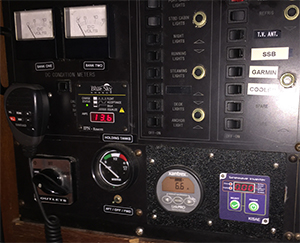 |
|
The breaker panel aboard Jill and Clayton Corbin’s Catalina 42, Me Too, with both digital and analog battery gauges. |
|
Clayton Corbin |
Jill and Clayton Corbin on the 1989 Catalina 42 Me Too — The Corbins’ boat is named after a term of endearment Clayton’s grandparents used before they were married nearly 70 years ago. In addition to Clayton and Jill, the other crewmember on Me Too is their daughter Briley. They have lived aboard since May 2013, preparing themselves and their boat for cruising the world. After three and a half years of planning and preparing, they departed San Diego with the intention of circumnavigating. Fifteen months later, they are now in New Zealand waiting out cyclone season in the South Pacific Ocean.
Ocean Navigator: What type of batteries do you use on board?
Jill & Clayton Corbin: Our main bank consists of four Lifeline AGM six-volt batteries and one Lifeline 8D battery. Two six-volts are run in series and then paralleled with each other and the 8D. We also have a 12-volt starting battery that is isolated from the main house bank. A Balmar charge controller manages the power from the engine alternator. On the Bimini, we have mounted two Kyocera 140-watt solar panels and two generic 100-watt panels, giving us a total of 480 watts of solar panels mounted high and out of the way. I also rigged in a small charge station for our phones and the Iridium GO. It consists of a folding 50-watt solar panel that charges a Power-Sonic 12-volt battery with a 28-amp-hour (Ah) capacity. This system is isolated and allows us to keep the Iridium GO on 24/7.
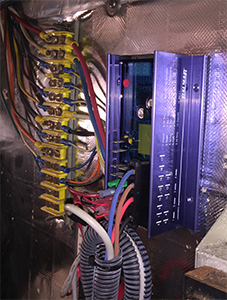 |
|
Me Too’s Balmar charge controller. |
|
Clayton Corbin |
ON: What is the capacity of your battery banks?
J&CC: We have a theoretical 295-Ah capacity.
ON: Do you use any type of battery management system for charging and measuring state of charge?
J&CC: A Xantrex LinkPRO monitor allows me to keep tabs on the condition of the batteries as well as their charging status. Separately, we use a Blue Sky controller that also displays house voltage and solar charge rate. There are also analog monitors on both the house and starter that I keep connected as a backup and for verification of the information I get from the digital monitors. The last monitor we have is our Kisae inverter control, which also displays house voltage as well as power draw in kilowatts.
ON: What changes, if any, do you plan to make to your battery setup?
J&CC: The current setup works well, but there are a few adjustments I will make in the future. The Kisae inverter is wired to the 8D, both of which are in our port lazarette. All the solar charging connections meet at the housing for the six-volt batteries, which is below the port stateroom. I would like to connect our two smaller (100-watt) solar panels directly to the 8D — it seems like that may help the life of the 8D. Secondly, when the time comes, I may replace the 8D with four more six-volt units.
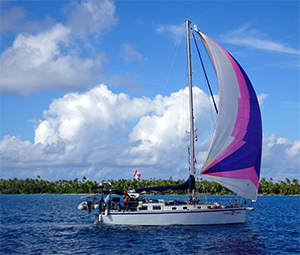 |
|
Deb and Phillip Perfitt’s 42-foot, steel-hull, David Folkes-design sloop Coastal Drifter. |
|
Phillip Perfitt |
Phillip and Deb Perfitt on Coastal Drifter — The Perfitts’ boat is a David Folkes-design, steel hull, 42-foot sloop built in 2006 by the previous owner. Phil and his wife Deb retired in 2013 and moved aboard the boat in Victoria, B.C. In July 2014, they cast off and circumnavigated Vancouver Island. They then headed down the West Coast of the U.S., landing at San Diego in January 2015. In April, they entered Mexico and spent the next two years cruising in the Sea of Cortez and Banderas Bay. Phil and Deb were cruising with their two granddaughters on board when they met Phil and Aimee Nance and their two daughters aboard the Dufour ketch Terrapin, and so the families frequently cruised together those two seasons. In April 2017, they crossed to French Polynesia in company with Terrapin and two dozen other cruising boats. Terrapin moved on, but the Perfitts stayed and are currently moored at Tahiti.
Ocean Navigator: What type of batteries do you use on board?
Phil & Deb Perfitt: Our battery setup is quite simple: two banks of two six-volt, deep-cycle, flooded batteries of 180-Ah each. Each pair is connected in series to give 12 volts DC, and the banks connect in parallel through a battery switch to a single buss bar.
I have installed several solar panels over the last few years, and now have two 100-watt Go Power flex panels, one 100-watt panel and two 150-watt generic panels. Each set has its own controller. On sunny days, the batteries reach 100 percent capacity by mid-afternoon. Alternatively, I have a pair of Honda EU2000i portable generators to run my watermaker. If needed, I’ll run one of these to power the AC battery charger — a ProMariner ProNautic 12-volt, 60-amp multibank smart charger. A few hours is all that’s needed to charge from 50 percent to 80 percent or more. Typically we use 30 to 40 percent per day, that being one of the cons of our setup: We use more than the Nigel Calder-recommended capacity of 30 percent daily.
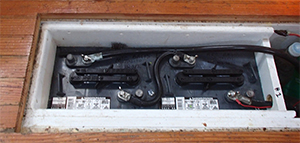 |
|
One of Coastal Drifter’s banks of six-volt batteries. |
|
Phillip Perfitt |
ON: What changes, if any, do you plan to make to your battery setup?
P&DP: I have thought about changing to lithium-ion batteries as they are highly recommended by cruisers who have them, but the cost is just too high for us now. A more realistic change is to increase capacity by adding another pair of flooded six-volts as our third bank, but that is on the back burner at present since the existing setup seems to meet our needs, albeit without a lot of excess capacity.
ON: What are some pros/cons of your current setup?
P&DP: An obvious downside of using portable generators is the need to store and transfer gasoline, sometimes while underway. In Mexico, I carried four 20-liter jerry cans for the generator and dinghy motor, but for the puddle jump I added three 20-liter cans for a total of 140 liters when full. It made me a bit of a floating gas station in remote atolls, but that’s the biz!
 |
|
Cat and Rich Ian-Frese in Patagonia. |
|
Rich Ian-Frese |
Rich and Cat Ian-Frese on the Tayana 37 Anna — Rich and Cat left Seattle after an 11-year refit of Anna. They started out heading in the general direction of South America, where they eventually took a right turn and crossed the South Pacific. They have refit, cruised and lived aboard Anna since 2000. Rich and Cat have visited as many nooks and crannies as they could find along the coast from Alaska and the Pacific Northwest to South America. They continued from South America across the South Pacific, remaining on Anna through two cyclone seasons in Polynesia, before continuing on to explore the Cook Islands, Niue, the Tonga chain and New Zealand.
Ocean Navigator: What type of batteries do you use on board?
Rich and Cat Ian-Frese: Our battery setup is two house banks of six-volt, 200-Ah Trojan AGMs (wired in series) for a total of four house batteries. We also have a separate 12-volt, 110-Ah, 31-AGM-type Trojan starter battery.
ON: What is the capacity of your battery banks?
R&CIF: We have a 400-Ah house bank and an isolated 100-Ah starter battery, which can be combined if necessary, although we’ve never needed to combine the two banks.
ON: Do you use any type of battery management system for charging and measuring state of charge?
R&CIF: For a battery bank monitor, we use a Xantrex Link 2000; for charger/converter, we use a Progressive Dynamics 9140A 40-amp converter with an Inteli-Power 9100 Charge Wizard. Our alternator is an Hehr Power Systems Powerline 120-amp, 12-volt, high-output unit; and for an alternator regulator, we have a Balmar ARS-5 and a Xantrex XAR as a backup.
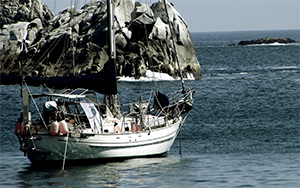 |
|
The Ian-Freses’ Tayana 37, Anna, which is equipped with solar panels and a wind generator. |
|
Rich Ian-Frese |
ON: What changes, if any, do you plan to make to your battery setup?
R&CIF: We aren’t planning any changes.
ON: What are some pros/cons of your current setup?
R&CIF: AGMs are maintenance free and practical when used in locations that are harder to access on a regular maintenance schedule. They can function upside down and perform well, unattended, for five to 10 years of fulltime use before replacement is required. They are reasonably inexpensive, especially when compared to lithium-ion.
The battery bank needs to be sized appropriately for 100 percent off-the-grid use with auxiliary solar and wind power. Our energy demand is low (65 amp-hours per day, more or less) so that our modest-output wind generator and distributed solar array (approximately 300 watts total) are sufficient to keep the batteries at 50 to 100 percent charge, day in and day out, without having to rely on our auxiliary Honda 1000 generator — unless conditions are extensively overcast and unusually calm for longer than four consecutive days.

